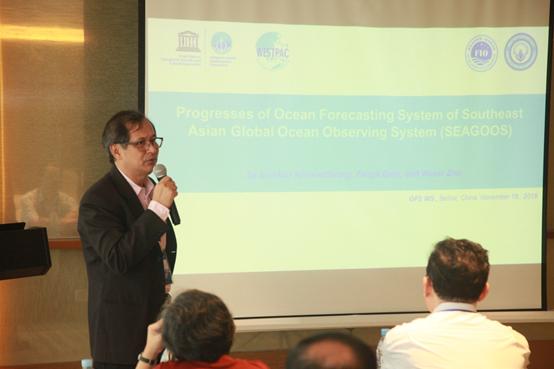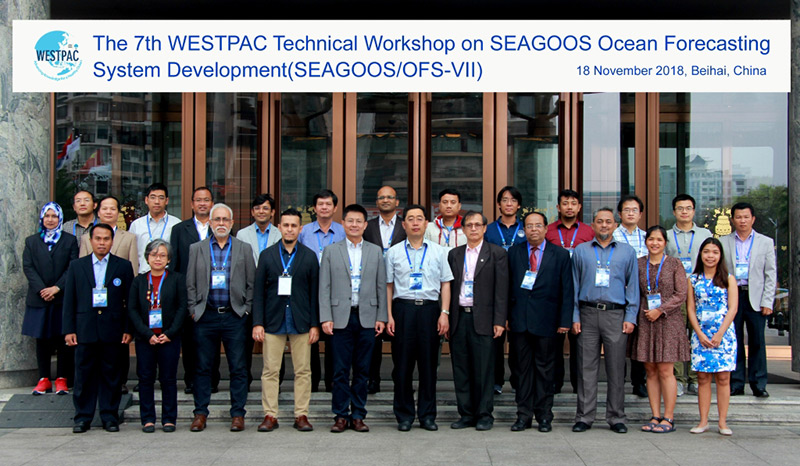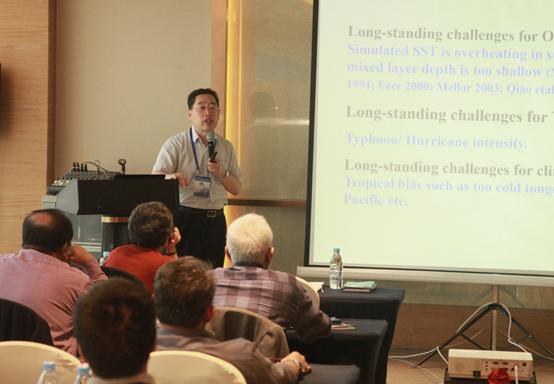The 7th IOC/WESTPAC Technical Workshop on SEAGOOS Ocean Forecasting System Development (SEAGOSS/OFS-VII) held successfully
On November 18, the 7th WESTPAC Technical Workshop on SEAGOOS Ocean Forecasting System Development (SEAGOSS/OFS-VII), was successfully held in Beihai City, Guangxi Province. This workshop was co-hosted by UNESCO/IOC/WESTPAC and the First Institute of Oceanography (FIO) of the Ministry of Natural Resources of People's Republic of China. A total of 32 experts, scholars, and representatives from China, Thailand, Malaysia, Indonesia, Vietnam, the Philippines, Myanmar, Bangladesh and other relevant international organizations, including WESTPAC and CLIVAR, attended the workshop.
WESTPAC is one of the most important maritime-related international organizations in the region, with 22 member states. OFS has made remarkable progress since it was formally launched in WESTPAC in 2010 and has become the flagship cooperation project of WESTPAC. Premier Li Keqiang initiated the launching of the China-ASEAN Investment Cooperation Fund at the 16th ASEAN-China Summit held in Brunei on October 9, 2013 and announced the first batch of 17 projects, where OFS was contained. In May 2012, the forecasting system was completed and officially launched by White Wendy, Assistant Director-General of UNESCO and Executive Secretary of IOC, and then entered into business operation in South Korea. On July 17, 2015, Chen Lianzeng, Deputy Director of State Oceanic Administration (SOA), People's Republic of China, and Mr. Wijam Simachaya, Deputy Permanent Secretary of Ministry of Natural Resources and Environment (Thailand), jointly cut the ribbon at the opening ceremony of OFS in Phuket, Thailand. Since OFS entered into business operation in Thailand, it has been applied in many fields such as shipwreck accident in Thailand on July 5, 2018, coral reef ecological protection, marine disaster reduction and prevention, possessing good forecast precision through verification. Since March 2018, OFS forecast results have been adopted and released by Malaysian Meteorological Department (MMD) on its national platform.
At the workshop, Qiao Fangli, a research professor who is in charge of the project, summarized the project's main progress in the past two years, which mainly includes: the breakthrough of typhoon numerical forecast model considering wave-induced mixing and foaming process; OFS system has become Thailand's national ocean forecast system, and the OFS products are published on the official website of MMD; based on such OFS products, a high-precision marine oil spill and search & rescue module was developed, which provided ocean current, sea wave and search & rescue range forecast for shipwreck accident in Phuket in 2018, and was actually adopted by Thailand government; meanwhile, the forecast results were confirmed by subsequent actual rescue results, providing a new successful example for practical application; the new visualization system for forecast products and mobile phone apps have been developed. Participants also discussed the work plan of the project for the next two years, which mainly includes: distribution and visualization of forecast products; development of high-resolution models in Gulf of Thailand, the Eastern Malay Peninsula Sea Area, and Andaman Sea Area; continuous development of joint survey cruises to obtain observation data to verify the ocean forecast system; organization of workshop and training courses on ocean observation techniques and numerical simulation techniques.
 Representatives from all countries at the workshop highly appraised and fully affirmed the progress of the OFS project, especially the case of the search and rescue application in Thailand, which aroused great interest among participants. They eagerly expected the project to expand to sea areas along the Maritime Silk Road as soon as possible so that operational forecast results for marine environment can be provided. They also indicated that they would actively participate in OFS project cooperation and promote the system in their own countries in the future to improve the marine ecological protection and marine disaster reduction and prevention capabilities of the entire region through high-level operational marine environment factor forecast.
|




